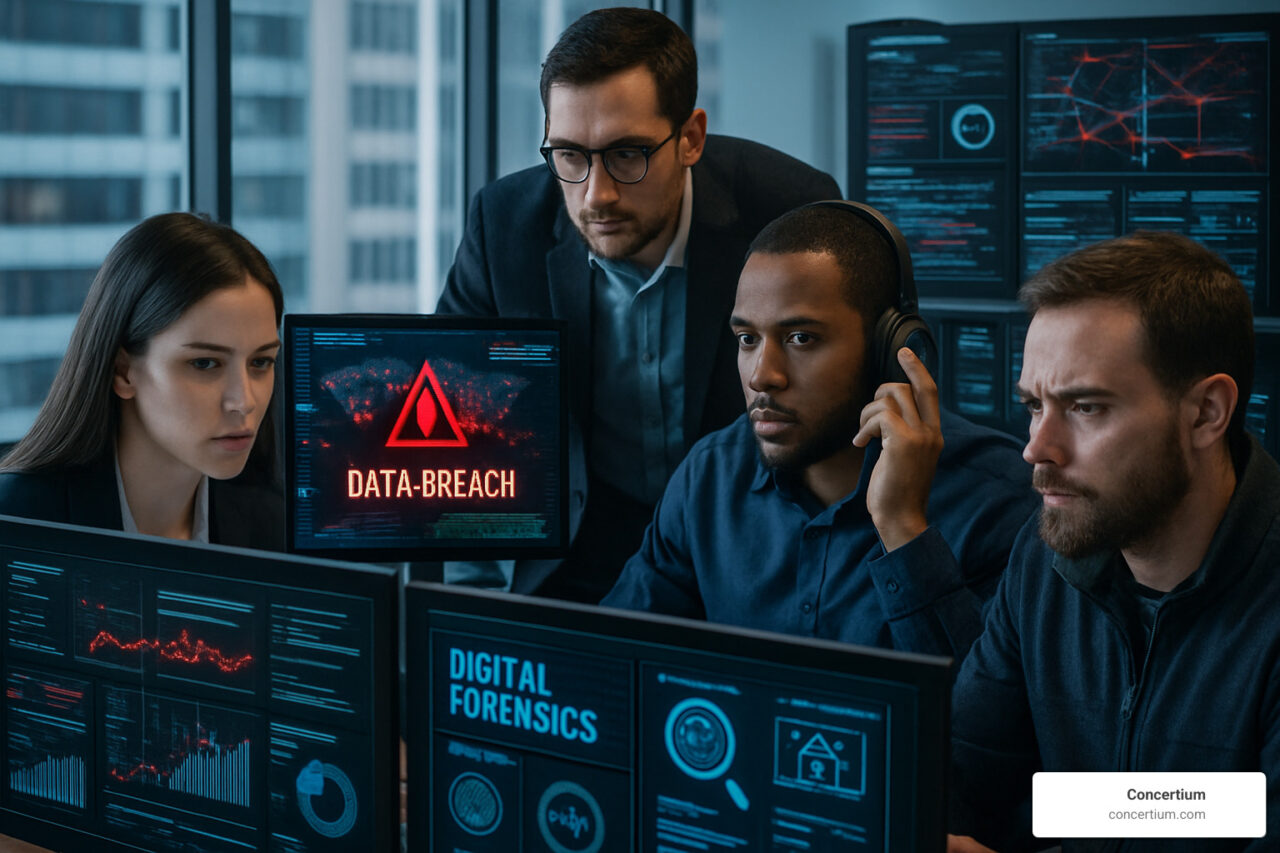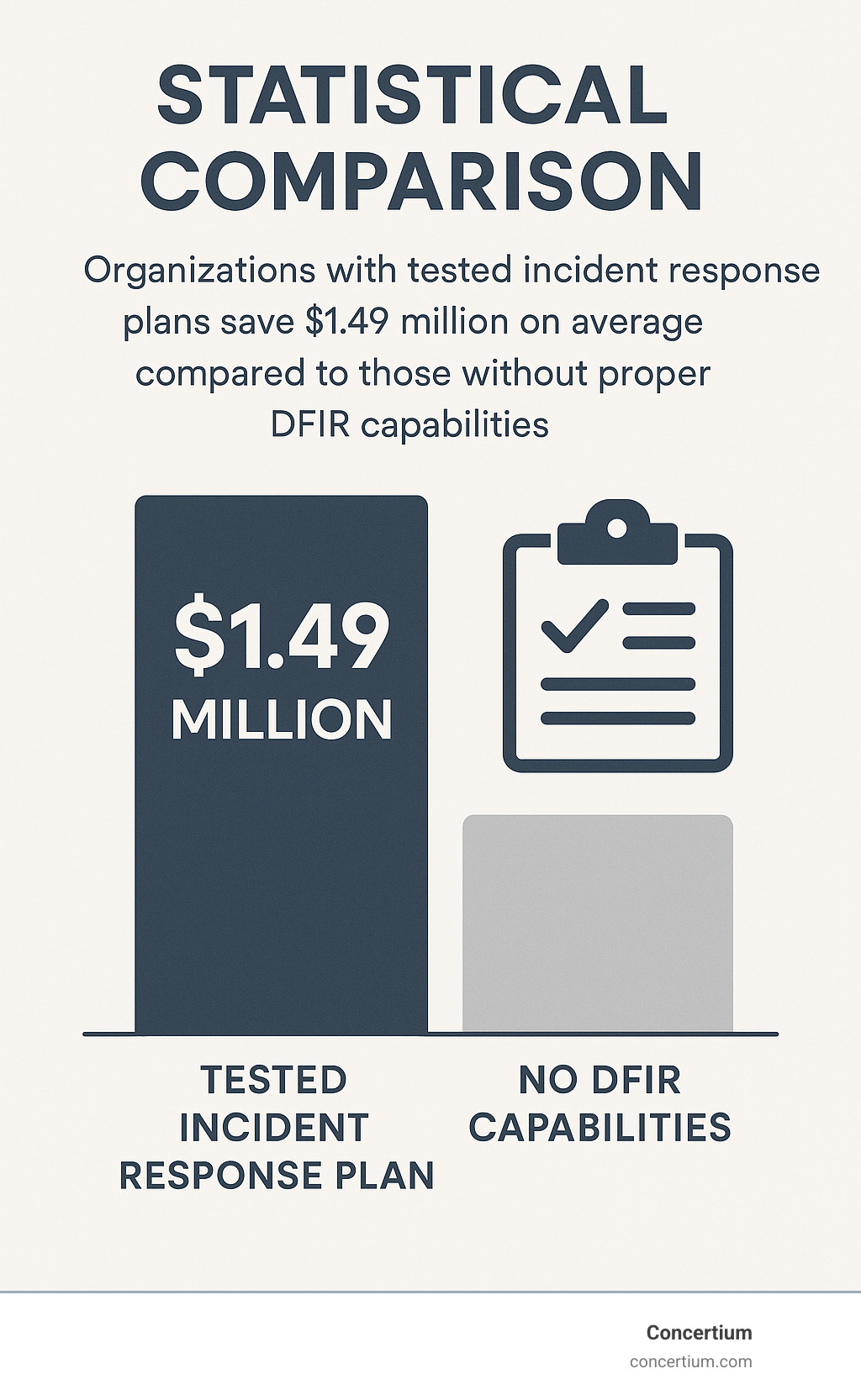Why Digital Forensics and Incident Response Matters More Than Ever
Digital forensics and incident response (DFIR) is CSI meets firefighting for your network. Digital forensics uncovers what happened; incident response stops the damage in real-time. Together, they help you:
- Preserve evidence for insurance, regulators, and courts
- Contain threats before they cripple operations
- Learn exactly how attackers got in so you can shut the door for good
Why it matters: The average breach now costs $4.45 million and takes 277 days to contain. Organizations with a tested DFIR plan save $1.49 million on average.
The modern threat landscape is unforgiving. Ransomware gangs run help desks, nation-state actors target critical infrastructure, and cloud, IoT, and mobile devices have multiplied the corporate attack surface. AI is accelerating both offense and defense, while regulations such as GDPR and HIPAA demand timely evidence preservation.
That’s why forward-thinking businesses treat DFIR as a single, integrated capability. While responders isolate infected systems, forensic analysts capture volatile memory and image disks so nothing critical is lost.
Digital Forensics and Incident Response (DFIR) 101
Early computer crime investigations of the 1980s birthed digital forensics, while the Morris Worm in 1988 kick-started formal incident response. For years they evolved separately: investigators worked slowly after the fact; responders worked fast in the moment—often wiping crucial evidence. Modern DFIR merges both.
| Digital Forensics | Incident Response |
|---|---|
| Evidence collection & analysis | Real-time threat mitigation |
| Scientific, methodical | Rapid, decisive |
| Output: legal-grade reports | Output: containment & recovery |
What Is Digital Forensics?
Investigators create bit-for-bit images of drives, grab volatile memory, and document every step to maintain an unbroken chain of custody. Deleted files, registry traces, browser artifacts, and in-memory malware all become clues that reveal the full attack timeline.
What Is Incident Response?
Incident response is the emergency plan that detects, contains, eradicates, and recovers from active threats. Tools like EDR and SIEM provide real-time visibility; playbooks and tabletop exercises ensure people know exactly what to do when seconds count. Our Cyber Incident Response services give organizations a head start.
How They Intersect
Unified DFIR means you can quarantine a host and capture its RAM in the same workflow, preventing evidence destruction and enabling fast root-cause analysis. The result: minimal downtime, stronger compliance posture, and actionable lessons for hardening defenses.
The DFIR Process Lifecycle
NIST SP 800-86 blends forensic science with the classic NIST incident-response cycle. Think of it as a repeatable recipe:
- Preparation – policies, tools, training
- Identification – confirm an incident exists
- Preservation & Collection – secure volatile data first, then disks, logs, and cloud artifacts
- Analysis – reconstruct timeline, scope, and impact
- Containment & Eradication – stop the attack, remove persistence mechanisms
- Recovery – restore systems safely
- Lessons Learned / Reporting – documentation, metrics, and improvements
Our NIST Incident Response Process guide shows how to implement each phase.
Maintaining Chain of Custody
Cryptographic hashes, detailed access logs, and secure evidence storage prove nothing was altered. One broken link can sink a court case, so DFIR teams treat documentation as seriously as analysis.
Essentials for Effective DFIR: People, Skills & Tooling
A 60 % talent shortage means you must combine smart staffing with smart tech.
Building the Dream Team
- DFIR Coordinator – bridges execs, legal, and tech teams
- Senior & Junior Analysts – perform collection and analysis
- SOC Analysts – triage alerts fast
- Security Engineers – apply fixes and hardening
Must-Have Tools
- Disk imaging: Autopsy, FTK
- Memory forensics: Volatility
- Visibility: SIEM plus EDR/XDR
- Automation: SOAR for repetitive tasks
Integrating Threat Intelligence
Mapping findings to MITRE ATT&CK and using the Pyramid of Pain helps teams shift from reactive cleanup to proactive hunting.
Overcoming DFIR Challenges & Best Practices
Common Pitfalls
- Volatile data loss – memory disappears on reboot.
- Poor documentation – kills legal admissibility.
- Narrow scoping – misses lateral movement.
- Single-tool dependence – no product sees everything.
Field-Tested Solutions
- Capture data in order of volatility.
- Use hardware write-blockers every time.
- Document everything with timestamps and tool versions.
- Drill regularly via tabletop exercises.
Need a quick checklist? See our guide on What to Do After a Cybersecurity Breach.
Post-Incident Hardening
Fix the root cause, update policies, improve monitoring, and include lessons in security-awareness training. Our Post-Breach Services turn hard-won insights into lasting resilience.
Building & Maturing Your DFIR Capability
Structuring a CSIRT
- Centralized – one team, clear ownership
- Distributed – domain experts handle their turf
- Fusion – central command with specialist pods
Document the charter early to avoid turf wars.
Improving Readiness & Speed
Automation plus practiced playbooks double response speed. Our Incident Response Cybersecurity resources show how to wire tools and people together.
Leveraging Third-Party Support
DFIR retainers give surge capacity and specialized skills without full-time overhead. The digital forensics market will hit $8.7 billion by 2027—evidence that expertise is only getting more valuable. Decide when to escalate with our Comprehensive Guide to Managing Incident Types.
Frequently Asked Questions about Digital Forensics and Incident Response
How do the two disciplines differ—and complement each other?
Forensics builds the legal case; incident response stops the bleeding. When combined, you keep systems running and preserve evidence.
What evidence is typically collected?
File-system artifacts, volatile memory, network captures, application and cloud logs, and increasingly mobile data—all secured under strict chain-of-custody rules.
How is chain of custody maintained?
Cryptographic hashes, detailed access logs, secure storage, validated tools, and expert testimony ensure evidence stands up in court.
Conclusion
In today’s threat landscape, the question isn’t if you’ll experience an incident—it’s when. A mature digital forensics and incident response program turns that inevitability into a manageable event. Tested plans save money, protect brand trust, and satisfy regulators.
Concertium’s Collective Coverage Suite (3CS) blends AI-improved observability with automated threat eradication, backed by nearly 30 years of expertise in Tampa, Florida. Ready to strengthen your DFIR posture? Explore our Incident Response Frameworks and start building cyber resilience today.
Call us at (813) 490-4260 to discuss a custom DFIR strategy for your organization.







